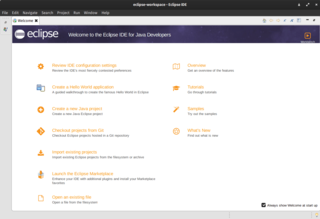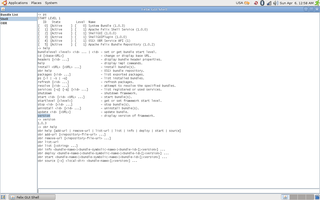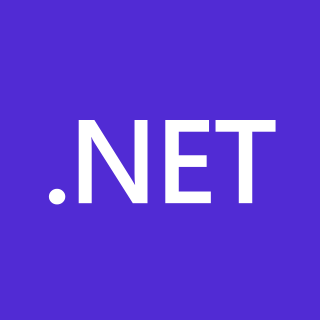Related Research Articles

OSGi is an open specification and open source project under the Eclipse Foundation.

Eclipse is an integrated development environment (IDE) used in computer programming. It contains a base workspace and an extensible plug-in system for customizing the environment. It is the second-most-popular IDE for Java development, and, until 2016, was the most popular. Eclipse is written mostly in Java and its primary use is for developing Java applications, but it may also be used to develop applications in other programming languages via plug-ins, including Ada, ABAP, C, C++, C#, Clojure, COBOL, D, Erlang, Fortran, Groovy, Haskell, JavaScript, Julia, Lasso, Lua, NATURAL, Perl, PHP, Prolog, Python, R, Ruby, Rust, Scala, and Scheme. It can also be used to develop documents with LaTeX and packages for the software Mathematica. Development environments include the Eclipse Java development tools (JDT) for Java and Scala, Eclipse CDT for C/C++, and Eclipse PDT for PHP, among others.
The Service Management Framework (SMF) is a software product by IBM which implements the OSGi Service Platform.

JOnAS is an open-source implementation of the Java EE application server specification, developed and hosted by the OW2 consortium, having been originally been created by Groupe Bull. JOnAS is released under the LGPL 2.1 open-source license.

GlassFish is an open-source Jakarta EE platform application server project started by Sun Microsystems, then sponsored by Oracle Corporation, and now living at the Eclipse Foundation and supported by Payara, Oracle and Red Hat. The supported version under Oracle was called Oracle GlassFish Server. GlassFish is free software and was initially dual-licensed under two free software licences: the Common Development and Distribution License (CDDL) and the GNU General Public License (GPL) with the Classpath exception. After having been transferred to Eclipse, GlassFish remained dual-licensed, but the CDDL license was replaced by the Eclipse Public License (EPL).
Equinox commonly refers to:
The Java Class Loader is a part of the Java Runtime Environment that dynamically loads Java classes into the Java Virtual Machine. Usually classes are only loaded on demand. The virtual machine will only load the class files required for executing the program. The Java run time system does not need to know about files and file systems as this is delegated to the class loader.

Apache Felix is an open source implementation of the OSGi Core Release 6 framework specification. The initial codebase was donated from the Oscar project at ObjectWeb. The developers worked on Felix for a full year and have made various improvements while retaining the original footprint and performance. On June 21, 2007, the project graduated from incubation as a top level project and is considered the smallest size software at Apache Software Foundation.
EclipseLink is the open source Eclipse Persistence Services Project from the Eclipse Foundation. The software provides an extensible framework that allows Java developers to interact with various data services, including databases, web services, Object XML mapping (OXM), and enterprise information systems (EIS). EclipseLink supports a number of persistence standards including:
IBM Lotus Expeditor is a software framework by IBM's Lotus Software division for the construction, integration, and deployment of "managed client applications", which are client applications that are deployed from, configured, and managed onto a desktop, usually by a remote server. The goal is to allow developers to create applications that take advantage of running on a local client, while having the same ease of maintenance as web-based applications.
Concierge is an OSGI R3 framework implementation intended for resource-constrained devices like mobile and embedded systems.

Spring Roo is an open-source software tool that uses convention-over-configuration principles to provide rapid application development of Java-based enterprise software. The resulting applications use common Java technologies such as Spring Framework, Java Persistence API, Thymeleaf, Apache Maven and AspectJ. Spring Roo is a member of the Spring portfolio of projects.

The .NET Framework is a proprietary software framework developed by Microsoft that runs primarily on Microsoft Windows. It was the predominant implementation of the Common Language Infrastructure (CLI) until being superseded by the cross-platform .NET project. It includes a large class library called Framework Class Library (FCL) and provides language interoperability across several programming languages. Programs written for .NET Framework execute in a software environment named the Common Language Runtime (CLR). The CLR is an application virtual machine that provides services such as security, memory management, and exception handling. As such, computer code written using .NET Framework is called "managed code". FCL and CLR together constitute the .NET Framework.
Virgo is an open source, OSGi-based, Java application server. Virgo supports the deployment of OSGi bundles and unmodified Java web applications as well as OSGi-influenced Shared Libraries WARs and Shared Services WARs.
The OSGi framework is a standardized module system and service platform for the Java programming language. The OSGi standards are defined in the OSGi Specification Project at Eclipse and published in OSGi specification documents such as the Core and Compendium specifications. These specifications contain chapters each of which describe a specific OSGi standard. This article contains a list of available implementations of OSGi standards, both commercial and open source implementations are included.
Franca Interface Definition Language is a formally defined, text-based interface description language. It is part of the Franca framework, which is a framework for definition and transformation of software interfaces. Franca applies model transformation techniques to interoperate with various interface description languages.
Excelsior JET is a now-defunct proprietary Java SE technology implementation built around an ahead-of-time (AOT) Java to native code compiler. The compiler transforms the portable Java bytecode into optimized executables for the desired hardware and operating system (OS). Also included are a Java runtime featuring a just-in-time (JIT) compiler for handling classes that were not precompiled for whatever reason, the complete Java SE API implementation licensed from Oracle, and a toolkit to aid deployment of the optimized applications. Excelsior JET was developed by Excelsior LLC, headquartered in Novosibirsk, Russia.

iDempiere. Community Powered Enterprise, also known as OSGi + ADempiere, is an open source Enterprise Resource Planning (ERP) software that is fully navigable on PCs, tablets and smartphones, it also has customer relationship management (CRM) and supply chain management (SCM) functions. It is in contrast to proprietary or most other open source ERP solutions driven only by a community of supporters.
Reactive Blocks is a visual model-driven development environment based on Activity Diagrams supporting formal model analysis, automated code generation, hierarchical modelling, and an extensive library of ready-to-use components for the Java platform.
References
- ↑ "Equinox Release Build: 4.21" . Retrieved December 1, 2021.
- ↑ "OSGi Alliance Certified Products". OSGi Alliance Site. Archived from the original on 2008-08-04. Retrieved 2008-10-03.
- ↑ Gruber, O.; Hargrave, B. J.; McAffer, J.; Rapicault, P.; Watson, T. (2005). "The Eclipse 3.0 platform: Adopting OSGi technology". IBM Systems Journal. 44 (2): 289–299. doi:10.1147/sj.442.0289. ISSN 0018-8670.
- ↑ McAffer, Jeff; VanderLei, Paul; Archer, Simon (2010). OSGi and Equinox : creating highly modular Java systems. Upper Saddle River, NJ: Addison-Wesley Professional. ISBN 978-0-321-58571-4.